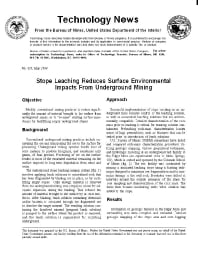Mining Publication: Technology News 436 - Stope Leaching Reduces Surface Environmental Impacts From Underground Mining
Original creation date: May 1994
Authors: Bureau of Mines
NIOSHTIC2 Number: 20025289
U.S. Department of the Interior, Bureau of Mines, Technology News 436, 1994 May; :1-2
Conventional underground mining practices include excavating the ore and transporting the ore to the surface for processing. Underground mining systems handle tons of solid material to produce kilograms, and sometimes only grams, of final product. Processing of ore on the surface results in most of the excavated material remaining on the surface exposed to long-term degradation from wind and water. The underground stope leaching mining system involves applying leach solutions to mineralized rock that has been fragmented by blasting ore in place, or by backfilling empty stopes. Only enough material is removed from the underground mining area (stope) to allow for adequate expansion during the blasting. This reduces the amount of material brought to the surface by at least two-thirds. After blasting, leach solution containing chemicals and/or bacteria is circulated through the fragmented ore to dissolve the target mineral. The resulting solution containing the dissolved mineral (pregnant leach solution) is pumped to the surface where the product is removed, and the leach solution is regenerated for recycling underground.

NIOSHTIC2 Number: 20025289
U.S. Department of the Interior, Bureau of Mines, Technology News 436, 1994 May; :1-2